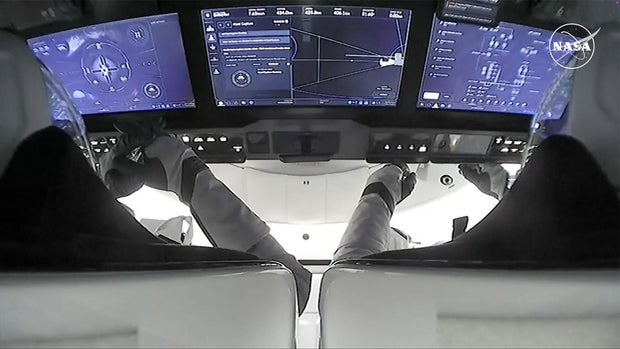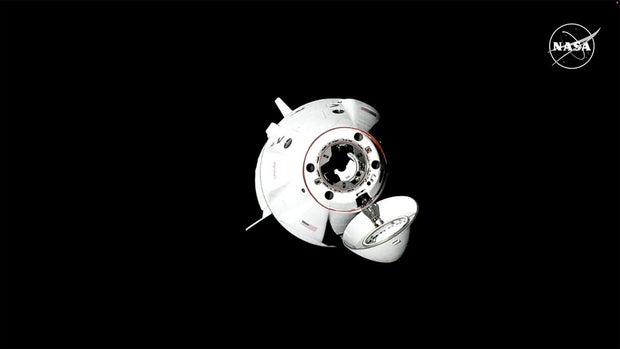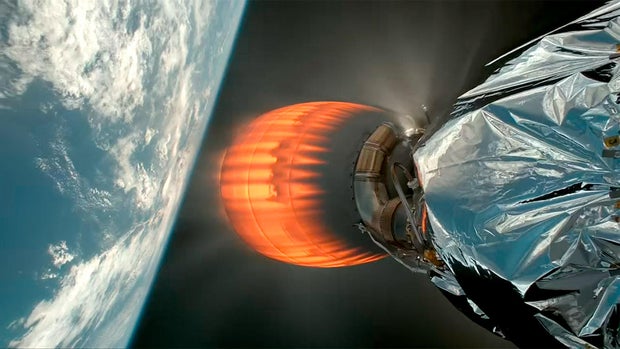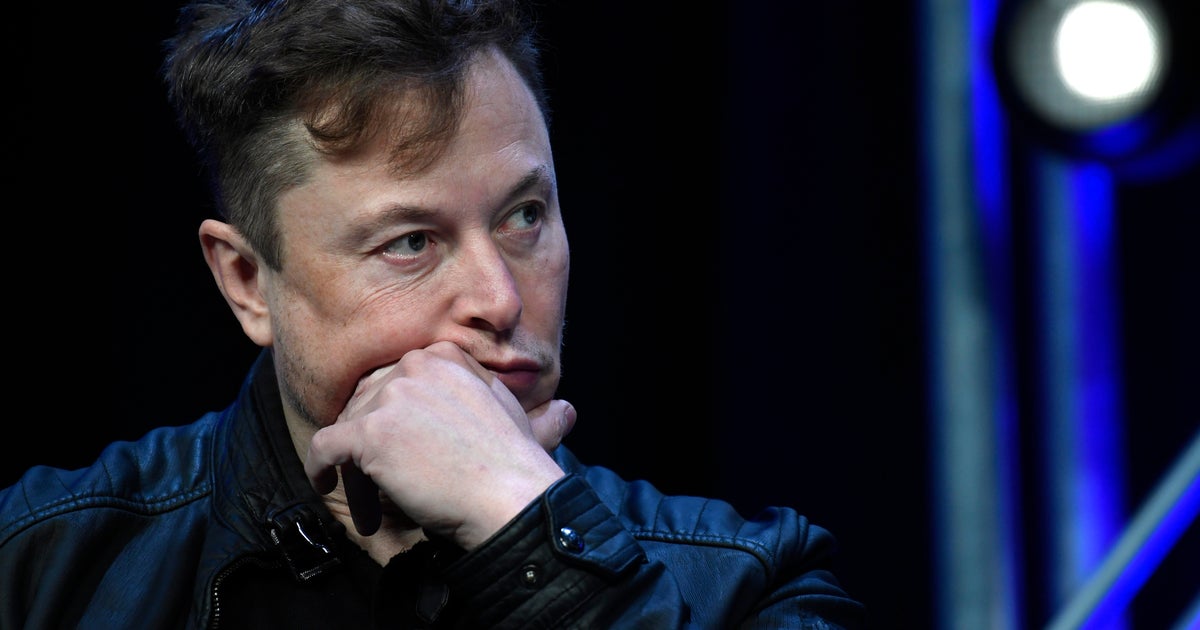CBS News
Crew Dragon brings two-man crew to space station amid probe of upper stage anomaly

A day after launching from the Kennedy Space Center, a SpaceX Crew Dragon spacecraft caught up with the International Space Station and moved in for docking Sunday, bringing a NASA astronaut and a Russian cosmonaut to the outpost to join two Starliner astronauts for a five-month tour of duty.
The rendezvous came amid word from SpaceX that it’s suspending Falcon 9 launches while engineers work to figure out what caused the crew’s Falcon 9 upper stage to misfire Saturday, after the Crew Dragon was released to fly on its own, resulting in an off-target re-entry over the Pacific Ocean.
Sen
SpaceX said in a post on the social media platform X that the second stage “experienced an off-nominal deorbit burn. As a result, the second stage safely landed in the ocean, but outside of the targeted area. We will resume launching after we better understand root cause.”
It was the second Falcon 9 upper stage anomaly in less than three months and the third failure counting a first stage landing mishap. It’s not yet known what impact, if any, the latest problem might have on downstream flights, including two high-priority October launches to send NASA and European Space Agency probes on voyages to Jupiter and an asteroid.
But the anomaly had no impact on the Crew Dragon’s 28-hour rendezvous with the space station, and the ferry ship, carrying commander Nick Hague and cosmonaut Alexander Gorbunov, docked at the lab’s forward port at 5:30 p.m. EDT as the two spacecraft sailed 265 miles above southern Africa.
Standing by to welcome Hague and Gorbunov aboard were Starliner commander Barry “Butch” Wilmore and pilot Sunita Williams, now serving as commander of the space station, along with Soyuz MS-26/72S commander Aleksey Ovchinin, Ivan Vagner and NASA astronaut Don Pettit.
Hague, Gorbunov, Wilmore and Williams will replace Crew 8 commander Matthew Dominick, Mike Barratt, Jeanette Epps and cosmonaut Alexander Grebenkin when they return to Earth around Oct. 7 to wrap up a 217-day stay in space.
Wilmore and Williams took off on the Starliner’s first piloted test flight, a mission expected to last a little more than a week, on June 5. During rendezvous with the space station the day after launch, multiple helium leaks in the ship’s propulsion system were detected and five maneuvering jets failed to operate properly.
SpaceX/NASA
NASA and Boeing spent the next three months carrying out tests and analyses to determine if the Starliner could safely bring its crew back to Earth. In the end, NASA managers decided to keep Wilmore and Williams aboard the station and to bring the Starliner down without its crew.
They made that decision knowing the two astronauts could come home aboard the Crew Dragon launched Saturday. Two Crew 9 astronauts — Zena Cardman and Stephanie Wilson — were removed from the crew to provide seats for Wilmore and Williams when Hague and Gorbunov return to Earth in February.
When they finally get home, Wilmore and Williams will have logged 262 days in space compared to five months for Hague and Gorbunov.
The Crew 9 flight was SpaceX’s 95th launch so far this year. And it was the company’s third flight in less than three months to run into problems.
NASA
SpaceX recovers, refurbishes and relaunches Falcon 9 first stage boosters, which can land in California, Florida or aboard off-shore droneships. The second stages are not recovered.
Instead, SpaceX commands upper stage engine firings to drive the stages back into the atmosphere for a destructive breakup, making sure any debris falls into an ocean well away from shipping lanes or populated areas.
By taking Falcon 9 upper stages out of orbit after their missions, SpaceX ensures they will never pose a collision risk with other spacecraft or add to the space debris already in low-Earth orbit.
During launch of 20 Starlink internet satellites on July 11, the Falcon 9’s second stage malfunctioned and failed to complete a “burn” needed to reach the proper orbit. Stuck in a lower-than-planned orbit, all 20 satellites fell back into the atmosphere and burned up.
SpaceX briefly suspended flights at the direction of the Federal Aviation Administration, but the problem was quickly identified and fixed, and the company was allowed to resume flights while the investigation continued.
Then, during another Starlink launch on Aug. 28, a Falcon 9 first stage descending to toward landing crashed onto the deck of an off-shore drone ship. SpaceX has not provided any information about what went wrong or what, if any, corrective actions were required, but flights resumed three days later.
SpaceX provided no details about the off-target re-entry of the Crew Dragon’s upper stage other than the post late Saturday on X.
SpaceX
Going into Saturday’s launch, SpaceX was planning to launch 20 OneWeb broadband satellites from Vandenberg Space Force Base in California this week, followed by a Starlink launch from Cape Canaveral. Both flights are now on hold.
More important, a Falcon 9 will be used to launch the European Space Agency’s $390 million Hera asteroid probe from the Cape Canaveral Space Force Station around Oct. 7, followed by launch of NASA’s $5.2 billion Europa Clipper Jupiter probe from the Kennedy Space Center on Oct. 10.
Hera is bound for the asteroid Didymos and its moon Dimorphos, a small body that NASA’s DART probe crashed into in 2022. Hera will study the system in detail to determine how the moon’s structure and orbit were changed by the impact. A primary goal is to learn more about how an asteroid threatening Earth some day might be safely diverted.
The Europa Clipper is a “flagship” mission to explore Jupiter’s ice-covered moon Europa and to determine the habitability of a vast sub-surface ocean. It is the largest planetary probe ever built, requiring a powerful Falcon Heavy rocket, made up of three strapped-together Falcon 9 first stages and a single upper stage, to send it on its way.
Both missions must get off the ground during relatively short “planetary” launch windows defined by the positions of Earth, Mars, Jupiter and the asteroids. Hera’s window opens on Oct. 7 and closes on Oct. 25. The Europa Clipper launch window opens on Oct. 10 and runs through Nov. 6.
Missing a planetary window can result in long, costly delays while while Earth, Jupiter, the asteroids and Mars, needed for gravity assist flybys, return to favorable orbital positions enabling launch.
Armando Piloto, a senior manager with the Launch Services Program at the Kennedy Space Center, said the Falcon Heavy stages used for the Europa Clipper mission will not be recovered. Instead, they will consume all of their propellants to achieve the velocity needed to send the probe on a five-year voyage to Jupiter.
“I’ll point out that during the burn of the second stage, the vehicle with the spacecraft, will be traveling approximately 25,000 miles per hour, which will be the fastest speed for a Falcon second stage ever for Europa Clipper,” he said during a recent briefing.
Given SpaceX’s rapid recoveries after the July and August malfunctions, the upper stage re-entry anomaly Saturday presumably will be resolved in time to get the Europa Clipper and Hera missions off the ground within their launch windows. But that will depend on the results of the latest failure investigation.
CBS News
“CBS Weekend News” headlines for Sunday, Sept. 29, 2024

Watch CBS News
Be the first to know
Get browser notifications for breaking news, live events, and exclusive reporting.
CBS News
Mezcal producers preserve traditional methods as demand for liquor grows | 60 Minutes

Watch CBS News
Be the first to know
Get browser notifications for breaking news, live events, and exclusive reporting.
CBS News
Vladimir Kara-Murza says he got warning during Russian prisoner swap | 60 Minutes

Vladimir Kara-Murza, a fierce critic of Vladimir Putin who was sentenced to 25 years in a Russian prison, was on his way to freedom after he was released during a prisoner swap when an FSB agent shared ominous parting advice.
“‘Be careful about what you eat. You know how these things happen,'” Kara-Murza said he was told.
Kara-Murza had already survived two poisonings — first in 2015 and then again in 2017. He was then arrested in 2022 and tried for treason last year after denouncing Putin’s war on Ukraine.
Kara-Murza knew the risks that come with speaking out against Putin, but he did it anyway.
“There are causes larger than ourselves. And to me, the cause of a free, peaceful, civilized and democratic Russia is certainly much larger than I could ever be,” he said.
Surviving poisonings
Kara-Murza had been high on Putin’s list since 2012, when he worked with the late Sen. John McCain on the so-called Magnitsky Act, a U.S. law named for a man murdered by prison guards. The Magnitsky Act allows for the seizure of the overseas assets of foreign officials who abuse human rights, and more than 60 people have been sanctioned.
60 Minutes
Kara-Murza says Kremlin assassins poisoned him in 2015 because of his work on the Magnitsky Act.
He was in a coma for about a month and suffered from multiple organ failure. Doctors in Moscow told his wife he had about a 5% chance of survival. As Kara-Murza was recovering, he had to learn how to walk and eat again.
“It’s amazing how fast the human body just loses everything, just loses all the strength and you just have to start anew,” he said.
Two years later, in 2017, he was poisoned again. This time, he went to the U.S., where his wife and three children live, to recover. Kara-Murza is a U.S. permanent resident.
But once he recovered, he returned to Russia.
“How could I not go back to Russia? I am a Russian politician. A politician has to be in their own country,” Kara-Murza said. “How could I call on my fellow citizens and my fellow Russians to stand up and oppose this dictatorship if I myself was too scared to do it? How is that possible?”
Kara-Murza continues speaking out as Putin cracks down
Kara-Murza says all of Putin’s opponents are either in exile, in prison, or dead.
Shortly after Russia launched its invasion of Ukraine in 2022, lawmakers passed a law imposing a 15-year prison sentence for those who criticize the war.
“We tried to warn the world. We tried to shout,” Kara-Murza said. “We tried to get the message out that this regime is dangerous, that this man is dangerous.”
After his treason conviction last year, Kara-Murza was hit with the longest sentence ever for a political prisoner. The judge in the case had been among the first Russian officials sanctioned under the Magnitsky Act.
Kara-Murza thought it was a “job well done” when he heard his sentence.
“I think that 25-year sentence was, frankly, a recognition that what we did over all those years mattered, that the Magnitsky Act mattered, that public opposition to the war in Ukraine mattered,” he said. “Yes, it means it was a job well done.”
Life behind bars and being freed
Kara-Murza spent two-and-a-half years imprisoned. He was sent to Siberia, and put in solitary confinement. He says he was only able to call his wife once and only allowed to speak with his children twice.
“And it was a 15-minute call, so five minutes per child,” he said. “And as my wife later told me, she was standing there with a stopwatch to make sure that each of our kids doesn’t get more than five minutes so that everybody could have an opportunity to speak with dad.”
He thought he would never get out, so he views what happened on Aug. 1 as a miracle.
“A large group of officers burst into my cell. I have no idea what’s happening. It’s the middle of the night. It’s dark,” Kara-Murza said. “And they tell me I have 10 minutes to get up and get ready. And at this moment, I’m absolutely certain that I’m gonna be led out and be executed.”
Instead, he was one of eight Russian dissidents released, along with several Germans and three Americans, in exchange for eight Russian criminals and spies. It was the largest prisoner exchange since the Cold War. President Biden’s administration, along with officials in several other countries, had spent months negotiating the prisoner swap.
After he stepped off a plane in Turkey, a diplomat from the American embassy came over and handed Kara-Murza a phone. President Biden was on the line, along with Kara-Murza’s family. They were calling from the Oval Office.
“It felt surreal, it felt more emotional than I had ever felt at any point in my life,” Kara-Murza said.
Continuing to speak out against Putin
60 Minutes correspondent Scott Pelley asked Kara-Murza if he thinks Putin will try to kill him.
“We know what it entails to be in opposition to Vladimir Putin,” Kara-Murza said. “He’s not just a dictator. He’s not just an authoritarian leader. He’s not just a strongman. He is a murderer. That man is a murderer.”
Kara-Murza, who remains in the U.S. with his family, shared his hopes that ordinary Russians standing up to Putin are remembered.
“I hope that when people in the West, that when people in the United States, when people in the free world at large think about Russia, they will remember not only the aggressors and the war criminals who are sitting in the Kremlin, but also those who are standing up to them,” he said. “Because we are Russians too.”













